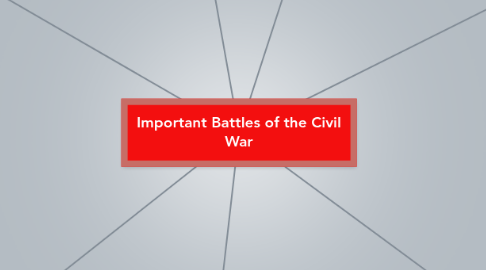
1. The War at Sea
1.1. Was a battle between the Union and the Confederacy at sea.
1.1.1. Prepare Product Evaluation
1.1.2. Conduct Product Evaluation
1.1.3. Initiate Maintenance Process
1.2. Confederacy's ship, Alabama, defeated nearly 60 of Union's ships before it was defeated.
1.2.1. Prepare for Project Closure Meeting
1.2.2. Conduct Project Closure Meeting
1.2.3. Follow Up Project Closure Meeting
1.3. South created the Ironclad which was powerful enough to take out numerous Union ships and went through the blockade.
1.3.1. Union created an Ironclad (U.S.S Monitor) to match the Confederacy's. These two ships faced off in the Battle of the Ironclads that ended in a tie.
1.3.2. War at Sea produced many technological advances such as the first Iron clad and the first submarine.
2. The First Battle of Bull Run (July 21st, 1861)
2.1. Government officials came to observe this battle.
2.2. First official battle of the Civil War.
2.3. Took place three months after Fort Sumter attack.
2.4. Union, led by General McDowell, lost within a day which made the South think the North wasn't powerful enough to fight.
2.5. After this loss, Lincoln replaced General McDowell with George B. McClellan.
3. Vicksburg (May 18th- July 4th, 1863)
3.1. On May 19th, 1835, Union General Grant sent forward thousands of his men into the Stockade Redan; Grant lost.
3.2. Grant tried again on May 21st, this time Union ships joined the attack on the Mississippi river; the Union was pushing up from the South which was Vicksburg's weakest point.
3.3. Grant kept pushing in on the Confederate army, building trenches, and forcing civilians to move into caves. The confederacy surrendered on July 4th due to loss of food at neared starvation.
3.4. Because of the loss, the Confederacy split in half. This loss resulted into the Confederacy losing one of it's largest strong holds in the War.
4. Sherman's March (November 15th- December 21st, 1864)
4.1. Union General Sherman marched 60,000 soldiers from Atlanta to Savannah in hopes to scare the Confederate supporters in Georgia.
4.2. Union soldiers stole food and burned down the houses of people who tried to fight back.
4.3. Union took hold of Atlanta, which was a major industrial center for the Confederacy.
4.3.1. This led to the March to the Sea. Confederacy was pushed out of Atlanta so they moved into Tennessee and Alabama, destroying Union supplies as they moved.
4.3.2. Sherman's army split into two wings. After Confederate's large defeat in Griswoldville, the Confederacy fled to the South destroying everything they could; the Union did followed suit,
4.3.3. The Union marched into Savannah in December 1864 where the previous confederate troops fled, the continued to scourge through South Carolina.
5. Shiloh (April 7th 1862)
5.1. April, 1862 that took place in Shiloh, Tennessee.
5.1.1. Confederates started surprise attack on General Grant's troops.
5.2. Tens of thousands of casualties.
5.2.1. Establish Project Objective
5.2.2. Establish Project Scope
5.2.3. Map Requirements
5.2.4. Map Solution
5.2.5. Map Training Requirement
5.2.6. Review Project Scope
5.3. Ulysses S. Grant, Union general, won that battle and this let the South know that the North was serious about the war.
5.3.1. Determine Project Approach, Stages and Steps
5.3.2. Estimate Project Duration
5.3.3. Establish Resource Requirements
5.3.4. Prepare Project Schedule and Budget
5.3.5. Prepare Work breakdown structure
5.3.6. Document Success Criteria
5.3.7. Review Project Schedule
6. Antietam (September 17th, 1862)
6.1. Robert E. Lee, Confederate General, led his army into the Northern states to create an aggressive attack.
6.1.1. Establish checkpoints
6.1.2. Acquire team resources for stage
6.1.3. Conduct stage kick-off meeting
6.2. Motivation for this battle was the hope that the state legislature would secede.
6.2.1. Determine Frequency of Meetings
6.2.2. Schedule Meetings
6.2.3. Brief Project Board
6.2.4. Prepare Meetings
6.2.5. Conduct Meetings
6.2.6. Follow-up Meeting
6.3. With 23,000 casualites,it was the deadliest single day throughout the entire war.
6.3.1. Schedule Quality Review Meeting
6.3.2. Prepare for Quality Review Meeting
6.3.3. Conduct Quality Review Meeting
6.3.4. Follow-up Quality Review Meeting
6.4. After Union's victory, the Confederacy had no choice but to retreat back to Southern territory.
6.4.1. Union's victory gives Abraham Lincoln enough hope to issue the Emancipation Proclamation.
7. Gettysburg (July 1st, 1863)
7.1. Lee wanted retaliation. He led his army once again into Northern territory (PA).
7.1.1. Wanted to destroy as many military posts as possible.
7.1.2. Lee wanted to defeat Lincoln and make the North lose hope in the War.
7.1.2.1. Lee also wanted recognition from France and Britain.
